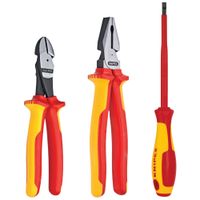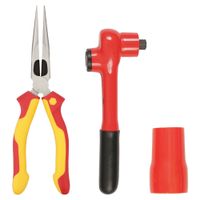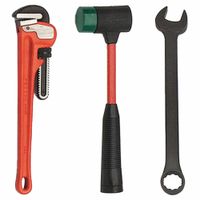Call +(254) 703 030 000 / 751 483 999 / 721 704 777
- Home
- Tools
- Hand Tools
- Assorted Tool Sets Kits
.....Read More
Frequently Asked Questions
What are the essential tools included in a general maintenance tool set?
A general maintenance tool set typically includes a variety of essential tools designed to handle a wide range of repair and maintenance tasks. Key components often include:
1. **Screwdrivers**: A set of flathead and Phillips screwdrivers in various sizes for driving screws and bolts.
2. **Wrenches**: Adjustable wrenches, combination wrenches, and socket sets for gripping and turning nuts and bolts.
3. **Pliers**: Needle-nose, slip-joint, and locking pliers for gripping, twisting, and cutting wires or small objects.
4. **Hammer**: A claw hammer for driving nails and a rubber mallet for tasks requiring a softer impact.
5. **Tape Measure**: A retractable tape measure for accurate measurements.
6. **Utility Knife**: A retractable blade knife for cutting materials like cardboard, plastic, and more.
7. **Level**: A spirit or bubble level to ensure surfaces are even and properly aligned.
8. **Allen Wrenches**: A set of hex keys for assembling furniture and working with hexagonal bolts.
9. **Drill and Bits**: A cordless drill with a variety of drill bits for making holes in different materials.
10. **Saw**: A hand saw or hacksaw for cutting wood, metal, or plastic.
11. **Flashlight**: A durable flashlight for working in low-light conditions.
12. **Electrical Tester**: A voltage tester or multimeter for checking electrical circuits.
13. **Tape**: Electrical tape, duct tape, and Teflon tape for sealing and insulating.
14. **Fasteners**: A selection of nails, screws, and anchors for various projects.
15. **Safety Gear**: Safety glasses, gloves, and ear protection to ensure personal safety during tasks.
These tools form the backbone of a versatile maintenance kit, enabling users to perform a wide array of repairs and installations efficiently.
How do I choose the right tool set for electrical work?
To choose the right tool set for electrical work, consider the following factors:
1. **Type of Work**: Identify the specific electrical tasks you will perform, such as residential wiring, commercial installations, or appliance repair. This will determine the tools you need.
2. **Essential Tools**: Ensure your tool set includes basic tools like screwdrivers (flathead and Phillips), pliers (needle-nose, lineman's, and diagonal), wire strippers, a voltage tester, a multimeter, and a tape measure.
3. **Quality and Durability**: Opt for tools made from high-quality materials like chrome-vanadium steel for durability. Insulated tools are crucial for safety when working with live circuits.
4. **Brand Reputation**: Choose reputable brands known for reliability and quality, such as Klein Tools, Fluke, or Milwaukee.
5. **Ergonomics**: Select tools with comfortable grips and ergonomic designs to reduce hand fatigue during prolonged use.
6. **Safety Features**: Look for tools with safety certifications, such as VDE or IEC, which ensure they meet international safety standards.
7. **Budget**: Determine your budget but prioritize quality and safety over cost. Investing in a good set of tools can save money in the long run.
8. **Portability**: Consider a tool set that comes with a sturdy case or bag for easy transport and organization.
9. **Expandability**: Choose a set that allows for future expansion, so you can add specialized tools as needed.
10. **Reviews and Recommendations**: Read reviews and seek recommendations from professionals or online forums to gauge the performance and reliability of the tool set.
By considering these factors, you can select a tool set that meets your needs, ensures safety, and provides long-term value.
What should I look for in a tool set for electric vehicle maintenance?
When selecting a tool set for electric vehicle (EV) maintenance, consider the following key factors:
1. **Insulated Tools**: Ensure the tools are insulated to handle high-voltage systems safely. Look for tools rated for at least 1000V to protect against electric shock.
2. **Specialized EV Tools**: Include tools specifically designed for EVs, such as battery management system (BMS) diagnostic tools, high-voltage cable cutters, and insulation resistance testers.
3. **Quality and Durability**: Choose tools made from high-quality materials to withstand frequent use and harsh conditions. Brands with a reputation for durability and reliability are preferable.
4. **Comprehensive Set**: A good tool set should cover a wide range of maintenance tasks, including wrenches, pliers, screwdrivers, multimeters, and torque tools. Ensure it includes both basic and advanced tools.
5. **Compatibility**: Ensure the tools are compatible with the specific make and model of the EVs you will be servicing. Some tools may be specific to certain manufacturers.
6. **Ergonomics**: Opt for tools with ergonomic designs to reduce fatigue during prolonged use. Comfortable grips and balanced weight distribution are important.
7. **Storage and Organization**: A well-organized tool set with a durable case or toolbox helps keep tools secure and easily accessible.
8. **Certification and Standards**: Look for tools that meet industry standards and certifications, such as CE, ISO, or ANSI, ensuring they are safe and effective for EV maintenance.
9. **Training and Support**: Consider manufacturers that offer training resources or customer support to help you effectively use the tools.
10. **Price and Warranty**: Balance cost with quality. A good warranty can provide peace of mind and protect your investment.
By focusing on these aspects, you can select a tool set that enhances safety, efficiency, and effectiveness in maintaining electric vehicles.
Which tools are necessary for a plumbing and HVAC tool set?
A comprehensive plumbing and HVAC tool set should include a variety of tools to handle installation, maintenance, and repair tasks. Essential tools include:
1. **Pipe Wrenches**: For gripping and turning pipes and fittings.
2. **Adjustable Wrenches**: Versatile for various nut and bolt sizes.
3. **Pipe Cutters**: For cutting copper, PVC, and other types of pipes.
4. **Tubing Cutters**: Specifically for cutting copper tubing.
5. **Basin Wrench**: Designed for working in tight spaces under sinks.
6. **Plumber’s Torch**: For soldering copper pipes.
7. **Thread Seal Tape**: To ensure leak-proof seals on threaded pipe joints.
8. **Plunger**: Basic tool for clearing clogs in toilets and drains.
9. **Auger/Snake**: For clearing deeper clogs in drains and toilets.
10. **Pliers**: Including slip-joint, needle-nose, and tongue-and-groove for gripping and twisting.
11. **Hacksaw**: For cutting through metal and plastic pipes.
12. **Pipe Bender**: For bending pipes without kinking.
13. **Manifold Gauge Set**: For diagnosing and servicing HVAC systems.
14. **Refrigerant Recovery Machine**: For safely recovering refrigerants.
15. **Vacuum Pump**: Essential for evacuating air and moisture from HVAC systems.
16. **Thermometer**: For measuring temperature in HVAC systems.
17. **Multimeter**: For electrical testing and troubleshooting.
18. **Leak Detector**: To identify refrigerant leaks in HVAC systems.
19. **Crimping Tools**: For securing fittings on PEX piping.
20. **Safety Gear**: Including gloves, goggles, and ear protection.
These tools are fundamental for professionals in plumbing and HVAC to efficiently perform their duties, ensuring systems are installed correctly and maintained effectively.
What are the benefits of using nonsparking tool sets?
Nonsparking tool sets are essential in environments where flammable or explosive materials are present. These tools are typically made from non-ferrous metals such as brass, bronze, copper-nickel alloys, or aluminum-bronze, which do not produce sparks when struck against other materials. Here are the benefits of using nonsparking tool sets:
1. **Safety in Hazardous Environments**: The primary benefit is the prevention of sparks that could ignite flammable gases, vapors, or dust. This makes them ideal for use in industries like oil and gas, chemical manufacturing, and mining.
2. **Corrosion Resistance**: Nonsparking tools are often resistant to corrosion, which is beneficial in environments where tools are exposed to moisture or chemicals. This extends the lifespan of the tools and ensures reliability.
3. **Durability**: While nonsparking tools are softer than steel tools, they are designed to withstand the rigors of industrial use. They are less likely to chip or break, which can be crucial in maintaining safety standards.
4. **Non-Magnetic Properties**: Many nonsparking tools are also non-magnetic, which is advantageous in environments where magnetic fields could interfere with equipment or where magnetic tools could attract metal particles, leading to contamination or equipment damage.
5. **Compliance with Safety Regulations**: Using nonsparking tools helps companies comply with safety regulations and standards, reducing the risk of accidents and potential legal liabilities.
6. **Versatility**: These tools can be used in a variety of applications beyond just hazardous environments, making them a versatile addition to any toolset.
Overall, nonsparking tool sets provide a safer alternative for working in potentially explosive atmospheres, ensuring both worker safety and operational efficiency.
How do I maintain and store my assorted tool sets properly?
To maintain and store assorted tool sets properly, follow these steps:
1. **Cleaning**: After each use, clean tools with a dry cloth to remove dirt and debris. For stubborn grime, use a mild detergent and water, then dry thoroughly to prevent rust.
2. **Lubrication**: Regularly apply a light coat of oil to metal parts to prevent rust and ensure smooth operation. Focus on moving parts like hinges and joints.
3. **Inspection**: Periodically inspect tools for damage or wear. Replace or repair damaged tools to maintain safety and efficiency.
4. **Organization**: Use a tool chest, pegboard, or tool rack to keep tools organized. Group similar tools together and label storage areas for easy access.
5. **Storage Environment**: Store tools in a dry, cool place to prevent rust and deterioration. Avoid damp or humid areas.
6. **Toolboxes and Cases**: Use toolboxes or cases with compartments to protect and organize smaller tools. Foam inserts can prevent movement and damage.
7. **Rust Prevention**: Use silica gel packs or rust inhibitors in storage areas to absorb moisture and prevent rust.
8. **Power Tools**: For power tools, remove batteries when not in use to prevent corrosion and battery drain. Store cords neatly to avoid damage.
9. **Sharpening**: Regularly sharpen cutting tools like saws and chisels to maintain efficiency and safety.
10. **Inventory**: Keep an inventory of your tools to track what you have and identify missing items quickly.
By following these steps, you can extend the life of your tools, ensure they are ready for use, and maintain a safe and efficient workspace.
Are there specific tool sets recommended for railroad maintenance and repair?
Yes, specific tool sets are recommended for railroad maintenance and repair to ensure safety, efficiency, and reliability. These tools are designed to handle the unique demands of railroad infrastructure, including tracks, signals, and rolling stock. Key tool sets include:
1. **Track Maintenance Tools**: These include rail grinders for smoothing rail surfaces, track jacks for lifting tracks, and rail saws for cutting rails. Track wrenches and spike pullers are used for fastening and removing track components.
2. **Inspection Tools**: Ultrasonic and magnetic rail flaw detectors are essential for identifying internal defects in rails. Track geometry cars and laser alignment systems are used to measure track alignment and gauge.
3. **Signal Maintenance Tools**: Multimeters and oscilloscopes are used for testing and troubleshooting signal systems. Specialized tools for maintaining and adjusting signal relays and circuit boards are also necessary.
4. **Rolling Stock Maintenance Tools**: Wheel lathes for re-profiling wheels, brake testers, and hydraulic jacks for lifting railcars are crucial. Diagnostic software tools are used for monitoring and analyzing locomotive performance.
5. **Safety Equipment**: Personal protective equipment (PPE) such as hard hats, high-visibility vests, and safety boots are mandatory. Lockout/tagout kits ensure safety during maintenance operations.
6. **General Tools**: Basic hand tools like hammers, wrenches, and screwdrivers, along with power tools such as drills and impact wrenches, are essential for various repair tasks.
7. **Specialized Tools**: Rail thermometers for monitoring rail temperature, and ballast regulators for maintaining track ballast, are also important.
These tools are often part of comprehensive maintenance programs that include regular inspections, preventive maintenance, and emergency repairs to ensure the safe and efficient operation of rail systems.





